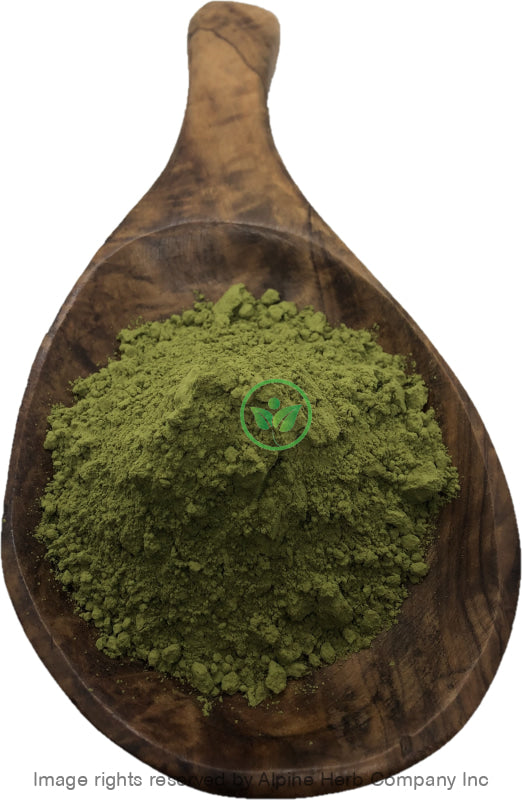Green Tea Macha Powder (Premium Grade) Alpine Herb Company Inc.
$ 13,99 $ 8,39
Botanical Name: Camellia sinensis
Common Name:
- English: Tea
- Unani: Chaai, Shaahi, Shaayi
- Also, known as: Tee, cha, Te, Thé, Chay, Tè, Da, Chai, Sa, The, Chay, Chah, Thaeyilai
Habitat: Native to Western China
Origin: China
Harvested: Cultivated
Parts Used: Leaves
General Information:
Green Tea Macha belongs to the same plant from where most other teas like Oolong standard, Black, White, and of course Green Teas come from. The powdered form of the handpicked, dried leaves called “Matcha Tea.”
The plant of the tea is covered with a jute net for at least a few weeks before it is being harvested. That keeps direct sunlight away from a plant. This slows the growth of the leaves, stimulating chlorophyll production, which in turn darkens the leaves which encourages the production of L-theanine, among other amino.
The best Matcha is produced from the leaves harvested from the very first of the season. That is why it is known as “1st Quality.” Moreover, the first-harvested Matcha leaves contain significantly more chlorophyll and more importantly, the amino acids. The more chlorophyll the Matcha contains, the more vibrant green the powder. And the more L-theanine the Matcha contains, the sweeter the taste.
Subsequently harvested leaves lower the grade of Matcha that can be identified by its color, test, and overall characteristic. The color of Matcha plays a huge role in deciding the quality of its kind.
First time harvested leaves give a bright green color. Those leaves are mostly young and first time harvested. It is known as a more premium quality.
Second time harvested leaves give green with a yellow tint. Those leaves are pretty much matured and mixed. It is known as culinary quality.
Lastly, if a Matcha has brownish color means it has derived from very matured leaves which contain very less amino acid. Test wise it could be more bitter. Many tea producers masked bitterness by using different flavoring agents.
How to use:
Hot Infusion:
The basic method for dried herbs and flower is, take 2-3 tablespoons of dried herb in a cup or teapot. Pour hot water over it and cover it with lid for 10-30 minutes. Hot water is needed to draw out the antioxidants, enzymes, vitamins, flavonoids, and volatile oils from the botanicals. Strain and squeeze out as much as liquid as possible and enjoy!
Tips:
- You can sweeten your herbal tea with a bit of honey, natural fruit juice, stevia leaves powder and or licorice root powder.
- You can make ice cubes or pops by freezing tea in ice trays or pop molds.
Precautions:
You should consult with a qualified healthcare practitioner before using any herbal products, particularly if you are pregnant, nursing, or on any medications.
All information on this website is for educational purposes ONLY.
This information has not been evaluated by Health Canada.
This information is not intended to diagnose, treat, cure, or prevent any disease.
| Unit Size | 50g, 100g, 200g, 400g |
|---|
Prompt shipping and expert packing
Thanks to our longstanding association with UPS FedEx DHL as well as other leading global carriers, we can offer a variety shipping options. Our warehouse staff is highly trained and will be able to pack your goods in accordance with our precise and exact specifications. Your items will go through an exhaustive examination before they will be securely packaged before being delivered. We ship to hundreds of thousands of customers daily in different countries. This is a sign of our determination to become the largest online retailer worldwide. Warehouses and distribution centers are located throughout Europe as well as in the USA.
Note that orders containing multiple items are processed according to the particular item.
We will thoroughly inspect all items ordered before shipping. Most orders are shipped within 48 hours. The delivery time will be between 3 and 7 working days.
Returns
The stock market is always changing. It's not entirely managed by us since we're involved with several entities, including the factory and the storage. Therefore, the actual inventory could fluctuate at any moment. Please be aware that it is possible that your order could be out of stock after you've placed your order.
Our policy lasts for 30 days. If it's been more than 30 days since the date you purchased your item We're sorry to say that we can't offer you a full exchange or refund.
You can only return a product if it is unused and still in the same state as when you received it. The item should be in the original packaging.
Related products
Herb Powder
Herb Powder
Herb Powder
Herb Powder
Herb Powder
Herb Powder
Herb Powder
Herb Powder
Herb Powder
Herb Powder
Herb Powder
Herb Powder
Herb Powder
Herb Powder
Herb Powder
Herb Powder
Herb Powder
Herb Powder
Herb Powder
Herb Powder


































